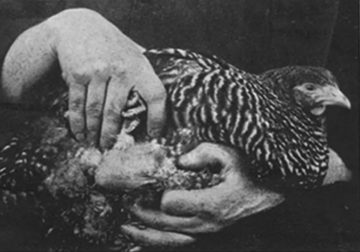Katherine Irving in The Scientist:
 In 1909, a chicken breeder approached Rockefeller Institute pathologist Peyton Rous with one of her hens. The chicken had a large, malignant tumor growing from the connective tissue in its breast, and Rous, who had long been fascinated by tumor biology and transmissibility, decided to investigate. He took biopsies and ground up the samples, then passed them through filters to remove any cells. Finally, he injected the mixture into healthy chickens of the same breed and watched as these chickens developed tumors of their own. This was to become the first major result that solid tumors can be infectious and spread through what some researchers at the time called “filterable agents,” now better known as viruses, which weren’t described in detail until the discovery of the electron microscope decades later.
In 1909, a chicken breeder approached Rockefeller Institute pathologist Peyton Rous with one of her hens. The chicken had a large, malignant tumor growing from the connective tissue in its breast, and Rous, who had long been fascinated by tumor biology and transmissibility, decided to investigate. He took biopsies and ground up the samples, then passed them through filters to remove any cells. Finally, he injected the mixture into healthy chickens of the same breed and watched as these chickens developed tumors of their own. This was to become the first major result that solid tumors can be infectious and spread through what some researchers at the time called “filterable agents,” now better known as viruses, which weren’t described in detail until the discovery of the electron microscope decades later.
These findings would eventually change the course of cancer research, but when Rous first reported his discoveries in 1910 and 1911, the scientific community was underwhelmed, according to Scripps Research cancer biologist Peter Vogt. “Rous made this big discovery, and at the time it was incredibly ahead of the field,” says Vogt, who coauthored a perspective piece on the virus, later named Rous sarcoma virus, or RSV (not to be confused with respiratory syncytial virus, also abbreviated to RSV). “People either didn’t believe him or belittled his work.”
More here.
